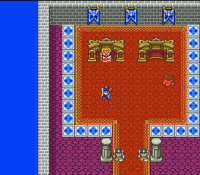Dragon Quest (video game)
|
|
| Dragon Quest I | |
| Developer(s) | Enix |
| Publisher(s) | Enix (Japan) Nintendo of America (NA) |
| Release date(s) | May 27, 1986 (JP) 1989 (NA) |
| Genre | RPG |
| Mode(s) | Single player |
| Rating(s) | ESRB: Everyone (E) (GBC) |
| Platform(s) | Nintendo Family Computer, MSX, Super Famicom, Game Boy Color, |
Dragon Quest I, the first game in the Dragon Quest series, was developed by Enix (now Square Enix) and released in 1986 in Japan for the MSX and the Nintendo Family Computer ("Famicom"). The game was localized for North American release in 1989, but the title was changed to Dragon Warrior avoid trademark infringement. Nintendo was impressed with the Japanese sales of the title and massively overproduced the cartridge, the end result was that Nintendo gave away copies of Dragon Warrior as an incentive for subscribing to Nintendo Power. Dragon Quest I has recently been released on cellular phones.
Dragon Quest I takes place in a country called Alefgard. A villain by the name of Dragonlord has kidnapped the princess of Tantegel and an artifact called the Orb of Light (a.k.a. Ball of Light). Eventually the hero who is a descendant of the legendary Erdrick has emerged and has vowed to rescue the princess and defeat the Dragonlord.
Dragon Quest was wildly popular in Japan and became the first in a series that now includes eight games, with several spin-offs, including Dragon Quest Monsters. Dragon Quest is regarded as the first console RPG (role playing game), a popular genre that also includes the Final Fantasy series. Seemingly primitive by today's standards, Dragon Quest features one-on-one combat, a limited array of items and spells, and only five town and five dungeons. Nevertheless, it was successful financially and well received by many fans.
In Japan many characters, locations, and spells had different names. In Japan Erdrick was originally called Roto (or Loto), King Lorik was called King Lars, Princess Gwaelin was known as Laura, and the Dragonlord was known as King Dragon. Tantegel castle was called Ladutorm Castle, Brecconary was called Ladutorm town, Garinham was called Galai, Kol was called Maira, and Cantlin was called Mercado. Charlock Castle was not named in the Japanese version. Spells generally had nonsense names, but the term for the heal spell, Hoimi, became the official term for heal in Japan. The Game Boy Color release of Dragon Warrior in the USA had a more accurate translation of many character and town names.
In the Game Boy Color remake Dragonlord's name was changed to Draco Lord, and Erdrick is now known as Loto. Several conveniences were added, such as a vault for storing gold and items, and a streamlined menu system. Monsters yield more experience and gold after being defeated to reduce the amount of time needed to raise levels and save up for purchases.
The Super Famicom remake was marketed exclusively in Japan due to the absence of Enix America Corporation, but it was unofficially translated into English and Spanish through emulation by online fan translation group RPG-One in 2002. The Game Boy Color version is based on the Super Famicom version. Most Dragon Quest fans consider the Super Famicom version to be superior to the Game Boy Color version.ja:ドラゴンクエスト

